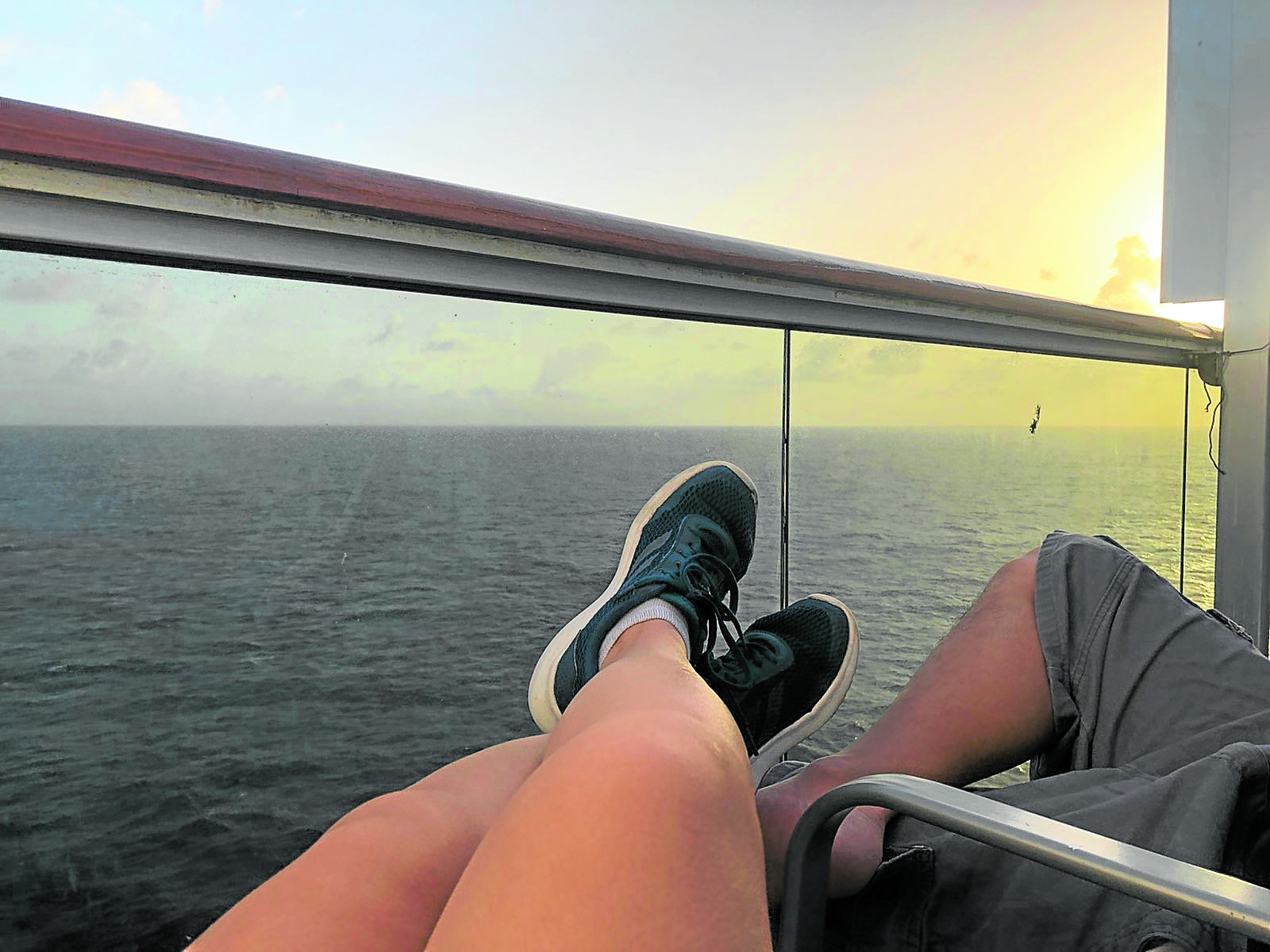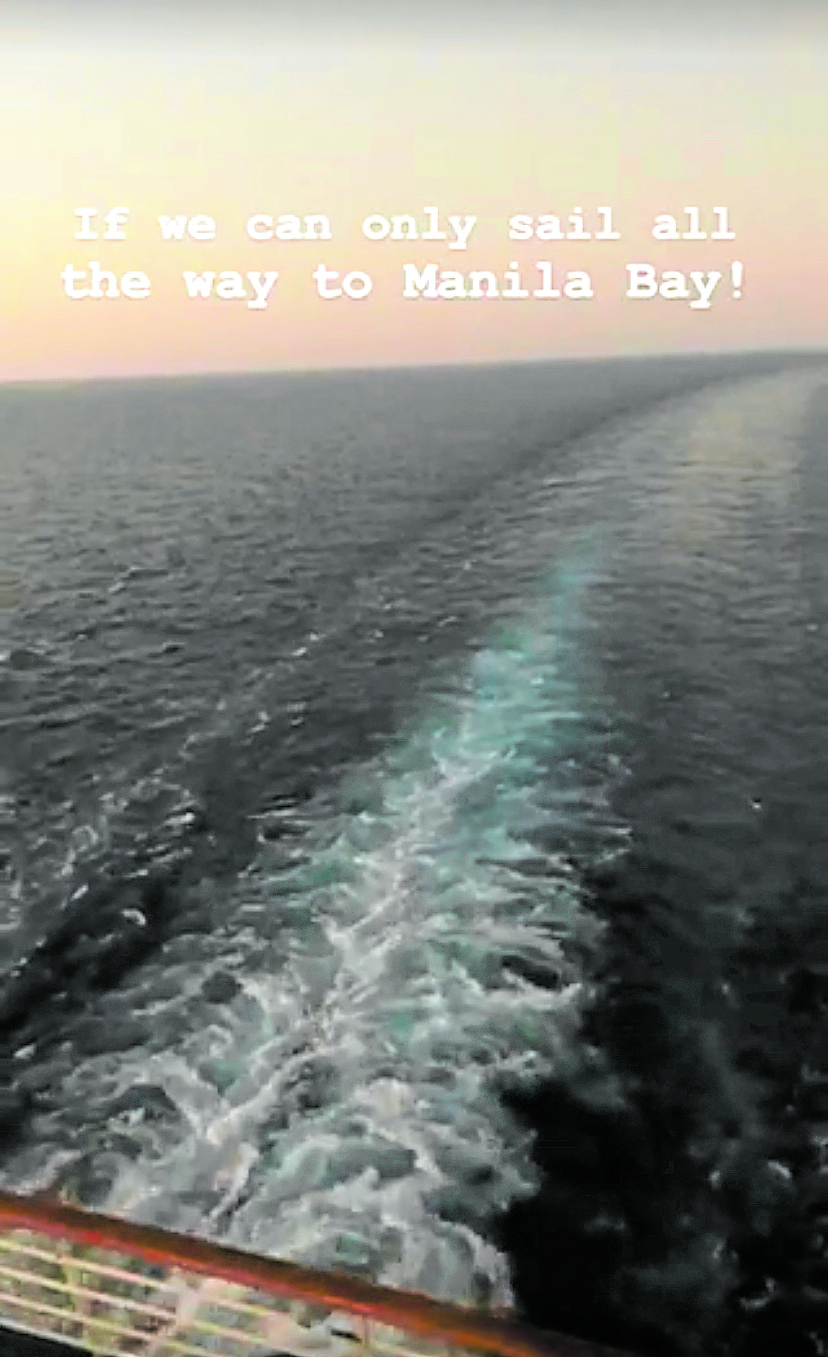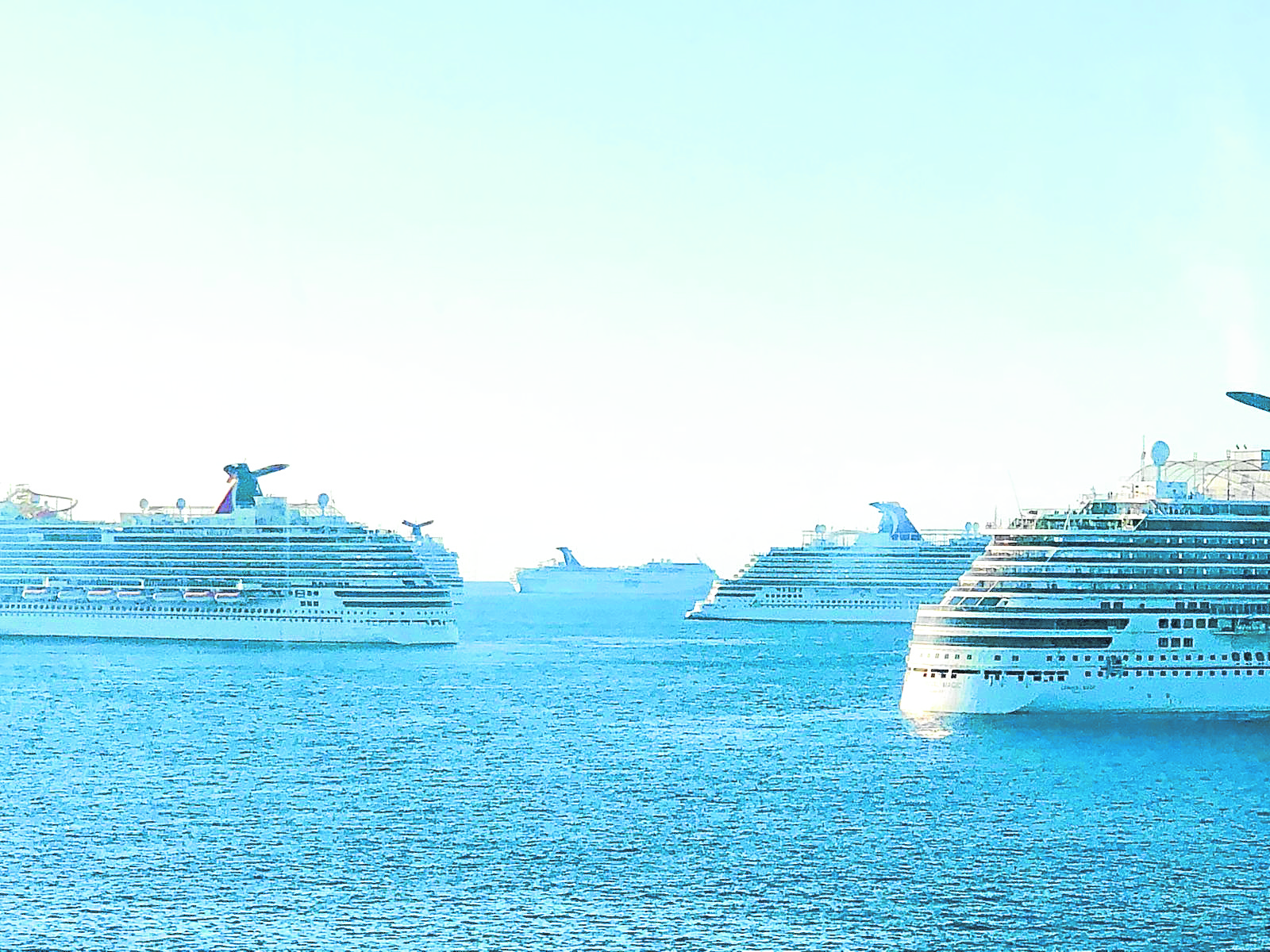When Jessica and Roger Santiago (not their real names) left the Philippines to work on a cruise ship in November and December, they vowed it would be the last time.
Jessica, who worked as an animator and youth staff, was on her third contract, while Roger, a music manager, was on his sixth. The money was good, and life as cruise ship workers had taken the husband and wife to many places—but it had also taken them away from their two kids.
But not anymore. Their contracts were ending in June, and the couple planned to stay put and start a business in the Philippines.
Then the pandemic happened.
News about the new coronavirus disease (COVID-19) reached the cruise ship, of course, but according to Jessica, “At first, we were just dismissing it.”
Roger, who had a view of the TV while performing with his band, soon realized that things had escalated. “When I saw that the NBA and NFL were canceling games, I knew it was serious.”
At a meeting with the company heads, Roger and the other managers were told that passengers would disembark at the end of their cruise on March 14 and no new passengers would board the ship.
Operations would pause for a month while they waited for things to normalize. No passengers for an entire month? It sounded like a paid vacation to them.
“We were so happy because that meant we didn’t have to work. And they even announced that we’d have free access to the internet so we could keep in touch with our families,” said Jessica.
Usually, ship workers have to pay for their own internet connection: $4 for 24 hours of social media or $10 for 100 minutes of internet.
They still did some work until the end of March—they cleaned, did inventory, worked on improving the show—but they also spent time enjoying the ship. Because of their positions, Jessica and Roger already had guest access to the ship. They could enjoy food in restaurants for guests and go to parts of the ship that are usually just for paying passengers. Not all cruise workers have that kind of access. That changed when the passengers left.
“Ang saya. Sa amin lang yung whole ship,” said Jessica. “Tapos lahat ng walang guest access, like the housekeeping people, biglang nakapunta na rin sila doon. Pwede na sila kumain sa pizza and burger joint. Everyone was happy.”
The pool was closed, the disco was closed, as was the gift shop, but the food was free and there was plenty to enjoy. The hardworking crew could relax, use the internet, eat and sleep as much as they wanted for days on end.
“There was no curfew yet at that point. Pwede pa umikot-ikot. There was a bar that was open so you could buy drinks and snacks. Masaya-saya pa,” said Jessica.

‘Basically useless’
But it soon became clear that the pandemic wasn’t going to just go away.
“Na-realize nung company na parang mas maganda atang pauwiin na lahat kesa paswelduhin pa kami kasi walang pumapasok na revenue,” said Roger. “I think kami yung unang department na binalak pauwiin or tanggalan ng sweldo. Those of us in the entertainment department were basically useless without guests.”
Their status changed from crew to guests in April. They were not going to be paid for their days on the ship anymore. The free internet access also stopped. “We were basically trapped there as guests,” said Roger.
They were told to book flights home if they could—the company would just reimburse the fares. Those whose homes were just a short flight away did that. Some managed to get home, but many of them ended up stuck in the airport with tickets they couldn’t use because countries were in lockdown. Some ended up returning to the ship.
The cruise ship company then started to charter flights so their employees could get home.
“Magulo yung system,” said Jessica. “They’d announce, ‘O, lahat ng Peruvians uuwi na kayo bukas.’ But on that day, biglang hindi tuloy yung Peruvians, yung Mexicans yung pauuwiin. So everyone just made sure they were packed and ready.”
Temperature checks started—the lines were always long. There were reminders about frequent hand-washing, but they weren’t wearing masks yet. Crew members usually shared rooms but were asked to separate because of social distancing. Jessica and Roger were allowed to continue staying in the same room since they were husband and wife.
They kept hearing about Filipinos aboard other ships already catching chartered flights home—some as early as the end of March. “Waiting in vain lang ang peg namin noon. For some reason, kami yung sobrang malas talaga,” Jessica said.
On April 10, they got good news. “Pinost na sa hallway yung mga groups na aalis—Filipinos and Indonesians daw—so tuwang-tuwa na kami,” said Jessica.
They packed their bags and left the ship. “We were on the bus on the way to the Miami Airport. It was a 5 1/2-hour drive from Tampa Bay,” Jessica said.
But an hour into the trip, the bus stopped. The Indonesians were asked to get off and transfer to another bus. “Tutuloy kasi sila sa airport. Kami, U-turn pabalik ng ship,” said Jessica.
U-turn
“Hindi daw nakakuha ng permit to land sa Naia (Ninoy Aquino International Airport),” said Roger. “Ang masaklap dun, since na-expose daw kami paglabas namin ng ship, kailangan namin lahat mag-14-day quarantine. Walang labasan ng room.”
There were 100 Filipinos on that bus. Roger said, “Parang naging big joke. Uuwi na kami dapat tapos biglang na-cancel at dahil na-cancel, kinulong kami sa cabins. Bwisit na bwisit kami but we were also thinking maybe we were safer on the ship. And at least we had lodging.”
This was around the time 6,000 overseas Filipino workers had just arrived in the Philippines from all over the world, and the government was scrambling to find places for them to quarantine.
From April 11 to 25, the quarantined Filipinos on that ship never left their rooms. Food was brought to their doors—the meals were a stark contrast to the usual cruise ship spread they enjoyed. But Jessica was grateful that at least she and Roger were together. She was also grateful that they were given window breaks.
Safety rules were stricter after their quarantine. People had started wearing masks. A curfew was imposed. The gym was closed.
At this point, the ship was just anchored off the coast of Florida. They weren’t docked because, apparently, ports charge a lot of fees for ships to be able to dock.

Sailing home
News started to spread aboard the ship that US President Donald Trump was banning land travel. The company then decided it might make more sense for the crew that still needed to be repatriated to do it by sea. On March 26, Jessica had posted a photo from the ship on social media with the caption, “If we can only sail all the way to Manila Bay.” She had no idea that in May, it would become a reality.
Jessica and Roger were in the United States and they were going to sail all the way to the Philippines. “Since mahal yung chartered flights at malabo, yung mismong ship na yung gagamitin para ihatid kami,” said Jessica.
That cruise line’s ships converged in the Caribbean, each one given a route to take crew members home. There were ships headed to Europe, Panama and the Caribbean. There were two ships headed to Asia. To board the one assigned to them, Jessica and Roger had to ride a lifeboat.
“Sobrang nakakahilo. Sobrang rocky. But we were willing to do anything just to get home.”
Soon the couple, along with other Filipino, Chinese, Sri Lankan, Thai, Indonesian and Korean crew members, were aboard the ship that was going to take them home.
But it wasn’t a direct route. They were going from the Bahamas to South Africa before sailing to Asia—news that shocked their families back in Manila. Africa?
“Ang daming stopover,” said Jessica. “In South Africa, the ship had to refuel and load goods.”
Usually, during regular cruise days, they actually got the chance to get off the ship and enjoy the different ports. But not on this long journey home.
On the new ship, Jessica and Roger were separated and assigned to different crew cabins. They insisted on staying together, though, and slept on a single bed. The next day, they requested to be moved to a bigger room.
Outside air
In those months that they were trying to make their way home, Jessica and Roger moved cabins so many times they lost count. That meant they had to keep packing and unpacking their stuff. They were always just grateful when they had access to a balcony—the ability to breathe in outside air was huge for them.
Their days on the ship crawled by. When they crossed a time zone, Jessica noted it in her diary. “We passed the equator today at 8 p.m.” “One hour forward! Past Madagascar already!”
They marathoned shows, they started jogging, they learned to cut each other’s hair.
“We kept telling each other, ‘Nami-miss ko na ang lupa,’” said Roger.
After days of seeing nothing but the expanse of the ocean, spotting mountains in the distance felt like a gift.
It was clear that the company was concerned for their mental health. The pool stayed closed, but they opened the dive-in movie theater and let the people on board watch films.
“We were hearing news of suicides on other ships,” said Jessica. “I think that’s why they held those screenings and opened the gym. They wanted to keep us sane.”
In South Africa, a lone crew member—a nurse—got off.
There weren’t a lot of announcements from the captain, and the internet connection on the ship as they traveled from the Bahamas to Asia was so bad that they couldn’t do video calls with their kids. They couldn’t even load the photos of their children that their parents were sending them. While they were in Durban, “TV Patrol” became their line to the outside world. “Buti na lang may TFC,” Jessica said.
The next stop was Bali and Jakarta, where 269 Indonesians debarked. “Nagkapalit-palit pa yung stops because may storm.”

Windowless cabin
Before arriving in the Philippines, the men aboard the ship were separated from the women. Roger was lucky to still have a balcony in his room. Jessica had the misfortune of being assigned to a windowless cabin that had no internet signal.
“We were told that the Philippine Coast Guard would board the ship to see if we were following protocol. Pinagbawal din yung air break, ewan ko bakit. But we were told it was the Coast Guard that decided,” she said.
It was at this point—away from her husband and stuck in a room with no view of the outside world—that cabin fever hit Jessica. It had been months since she set foot on solid ground.
“I was just watching ‘The Big Bang Theory’ when I suddenly screamed, ‘Gusto ko nang umuwi!’ It was involuntary. I normally don’t have outbursts like that.”
She found solace in her makeup kit. “Hay naku, magdamag na lang akong nag-makeup,” she said. “I also learned dances. There was one night we had an all-girls inuman in one cabin. We also played cards with colleagues one night.”
Being stuck there was easier for Roger, who is an introvert. But it was a struggle for Jessica, who likes socializing.
Some enjoyed the experience, though, like Jessica’s single friends, who spent the days on the ship drinking and partying. And then, of course, there was sex and romance on the ship.
Despite the free condoms provided by the ship’s medical center, by the time they reached Manila, there were 16 pregnancies on board and even more pregnancy scares. One of Jessica’s friends thought she was pregnant, so she went to the nurse. “The nurse told my friend that she was the seventh person to get a pregnancy test that day,” Jessica said.
Jessica and Roger had been hoping to get home by June 14 for their son Jeff’s birthday. But it wouldn’t happen.
So close to home
With the ship finally in Philippine waters, on June 30, Red Cross teams boarded the ship to conduct swab tests. They were so close to home, but still had to wait. When their test results came out, they were asked to email them so their company could process their debarkation.
One batch of Filipinos was already on a lifeboat headed to the pier when they were asked to return to the ship because they had no permit to set foot on land. They had to wait an extra night.
Jessica got her results first, but Roger was given permission to finally leave the boat ahead of her. “Magulong-magulo lahat,” he said.
Roger had to leave the ship without Jessica. “Nung finally nakatapak na ako sa lupa, ibang-iba yung feeling, hindi ko ma-explain,” he said.
Repatriation stopped at 6 p.m. each day. And just before that day ended, there was an announcement: 50 more people were going to be allowed to get off the ship. Jessica was number 50.
Finally, luck was on their side.
They were reunited in Intramuros and headed home together.
Jessica talked about the moment she finally saw their kids again. “Oh my gosh! Gusto ko na sila i-hug pero kailangan munang maligo. Sobrang gigil at saya! Parang nag-cross ng finish line after almost four months.”
Their journey wasn’t the most difficult, the couple said. There were fellow Filipinos who still had to make the journey to the Visayas and Mindanao. And then there were the other Asian workers who headed to Naia to get flights home.
If the pandemic didn’t happen, if Jessica and Roger had finished their contracts, they would have gotten home on June 3. Instead, after their circuitous route, they arrived on July 8.
Roger said, “Yung feeling ko can be summarized in one word: finally. Nakatulog na rin ako nang mahimbing afterward. Kasi before nun, restless ang feeling, eh.”
The pandemic has disrupted the couple’s plans. Their business plans are on hold. Roger will also need to work on a cruise ship again.
“I am just waiting for the operations to resume again, whenever that will be,” he said. “But for now, we’re just enjoying being home with the kids.”








































